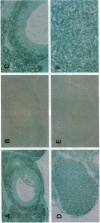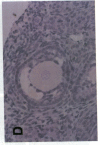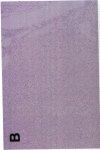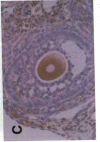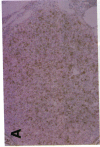Abstract
Corticotropin-releasing hormone (CRH), the principal neuropeptide regulator of pituitary ACTH secretion, is also produced at peripheral inflammatory sites, where it acts as a proinflammatory cytokine, and by the Leydig cell of the testis, where it exerts autocrine inhibition of testosterone biosynthesis. Because key ovarian functions, such as ovulation and luteolysis, represent aseptic inflammatory responses, and because the theca cell is the functional equivalent of the Leydig cell, we explored the CRH presence in the ovary, first, by specific CRH immunohistochemistry of adult cycling female Sprague-Dawley rat ovaries. We detected cytoplasmic immunoreactive CRH (IrCRH) in theca and stromal cells and in cells within the corpora lutea, at all phases of the estrous cycle. Using a specific radioimmunoassay, we measured IrCRH in extracts of rat ovaries (0.042-0.126 pmol/g wet tissue). The mobility of the ovarian IrCRH molecule was similar to that of rat/human CRH by reverse phase HPLC. To investigate the CRH action in the ovary, we identified, characterized, and localized CRH receptors in the rat ovary. Binding was linear with increasing tissue concentration, saturable, and of high affinity. Scatchard analysis of 125I-Tyr-ovine CRH competitive displacement curves indicated a high affinity binding site with a Kd of approximately 6 nM and a Bmax value of approximately 61 fM/mg protein. Autoradiographic studies revealed CRH receptors primarily in ovarian theca and stroma. We conclude that IrCRH and CRH receptors are present in rat ovaries, suggesting that this neuropeptide may play a regulatory role in this gonad, perhaps through its proinflammatory properties and/or by participating in the auto/paracrine regulation of steroid biosynthesis. Functional studies are necessary to define the role(s) of CRH in the ovary.
Full text
PDF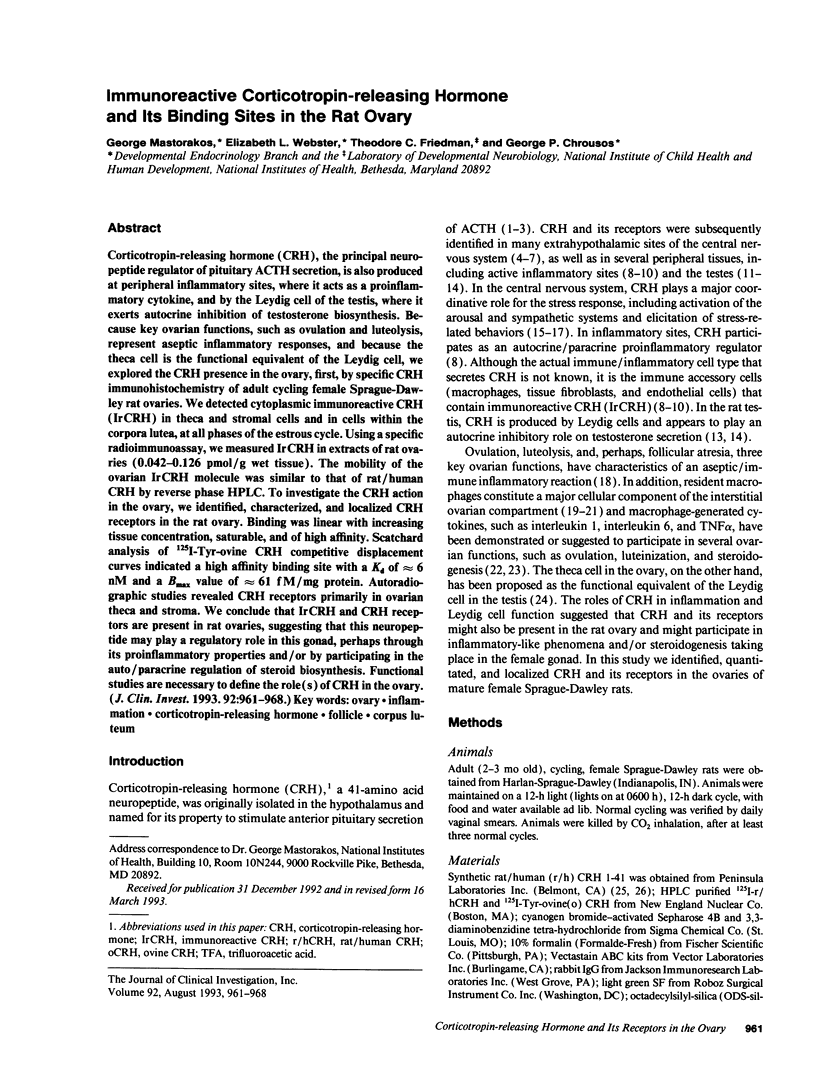
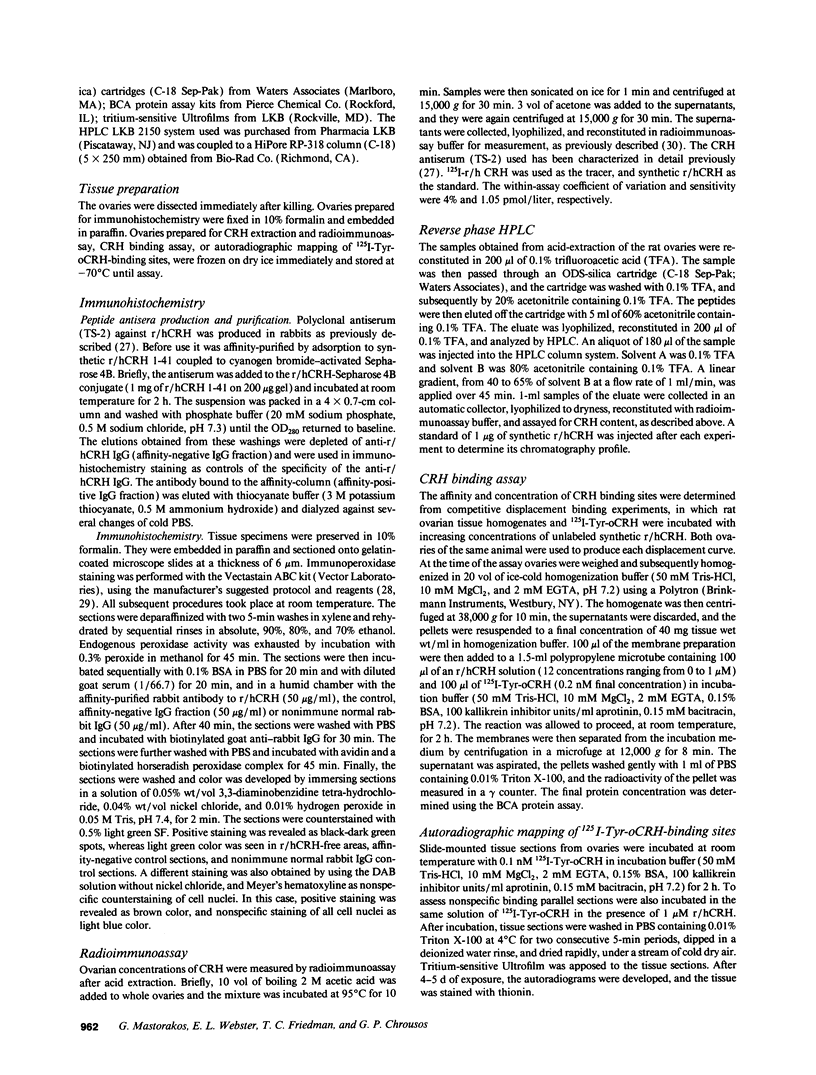
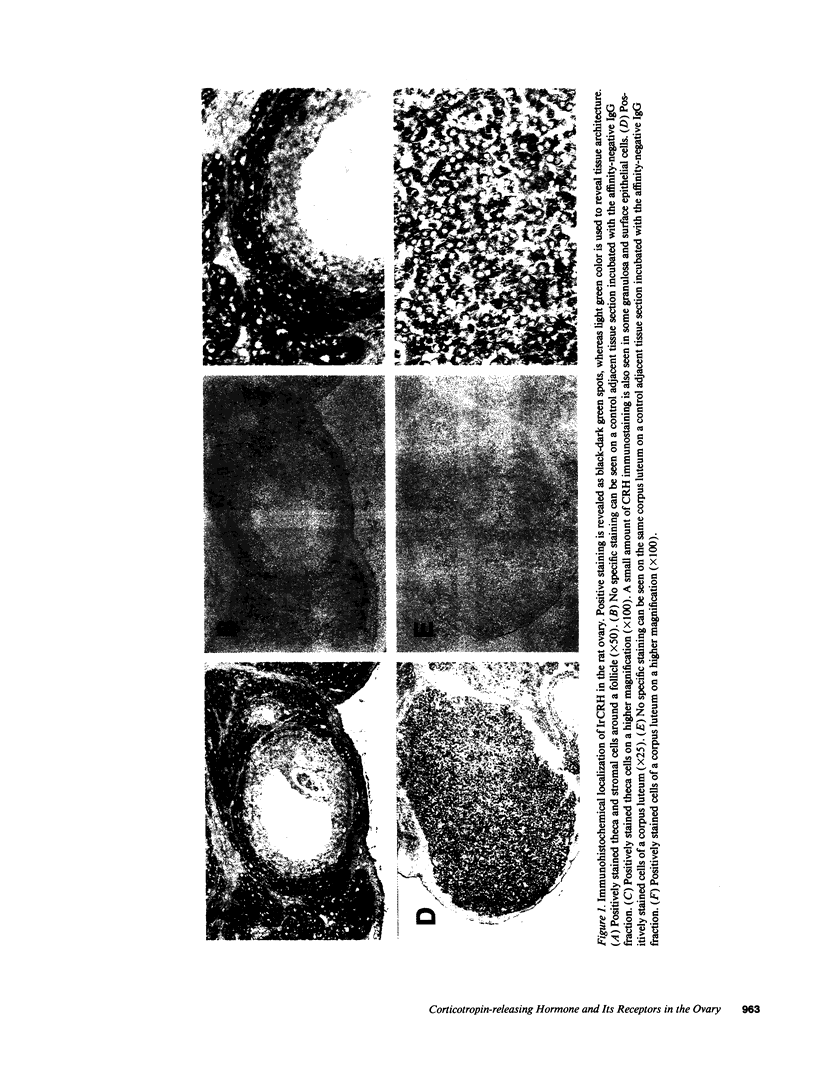
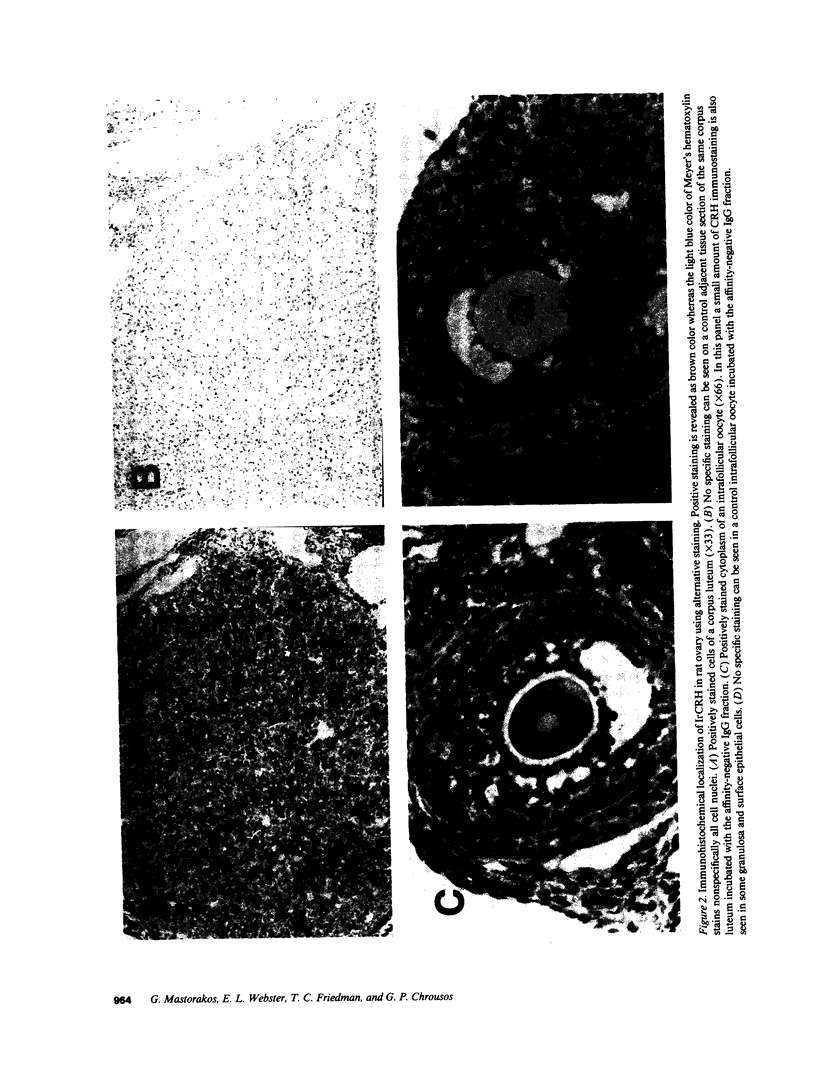
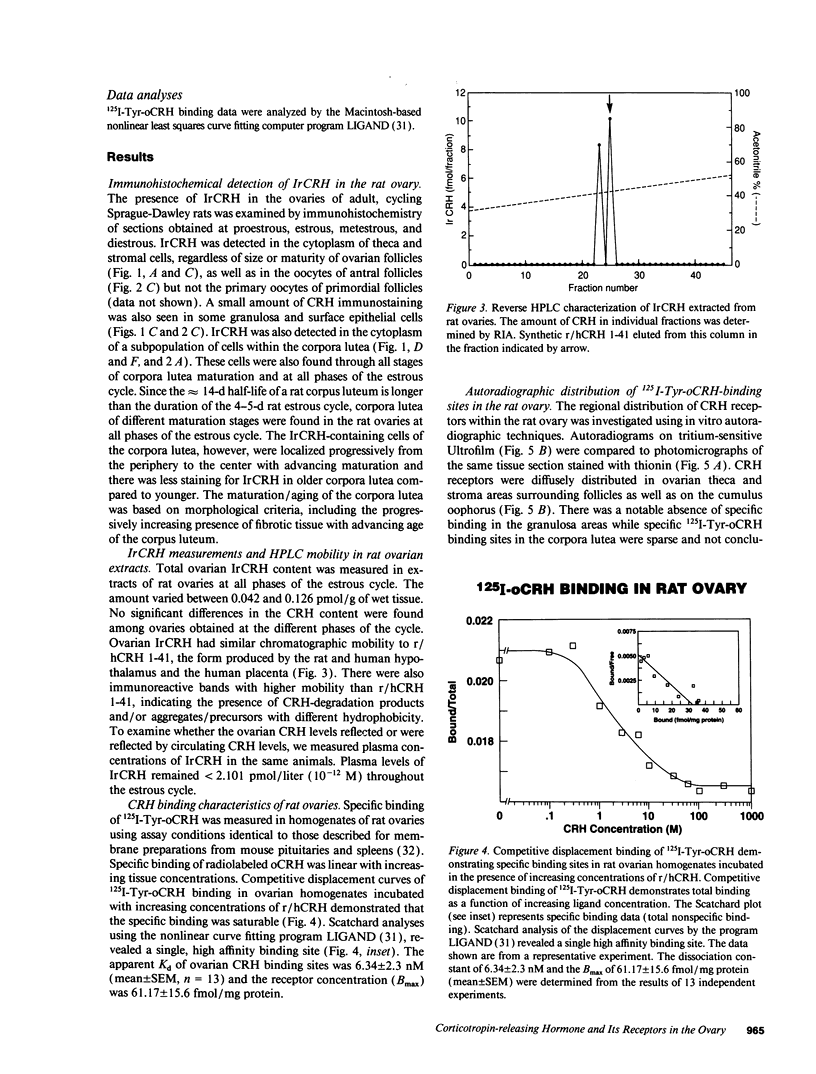
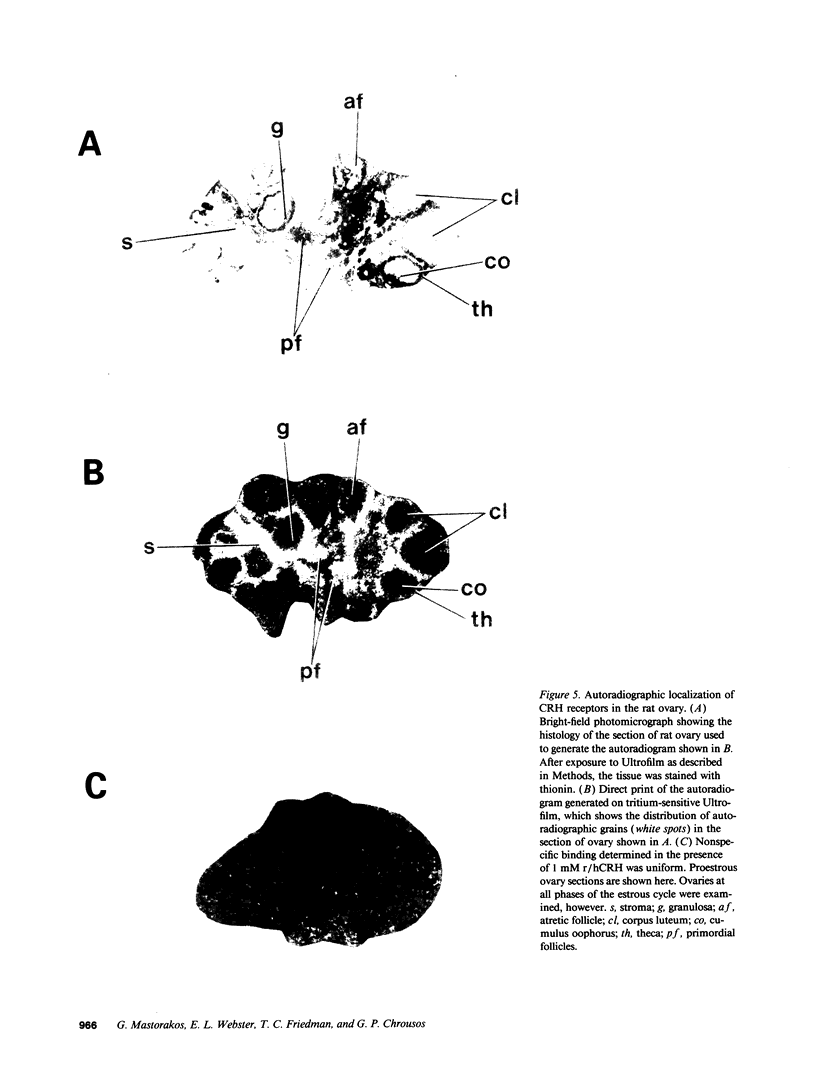
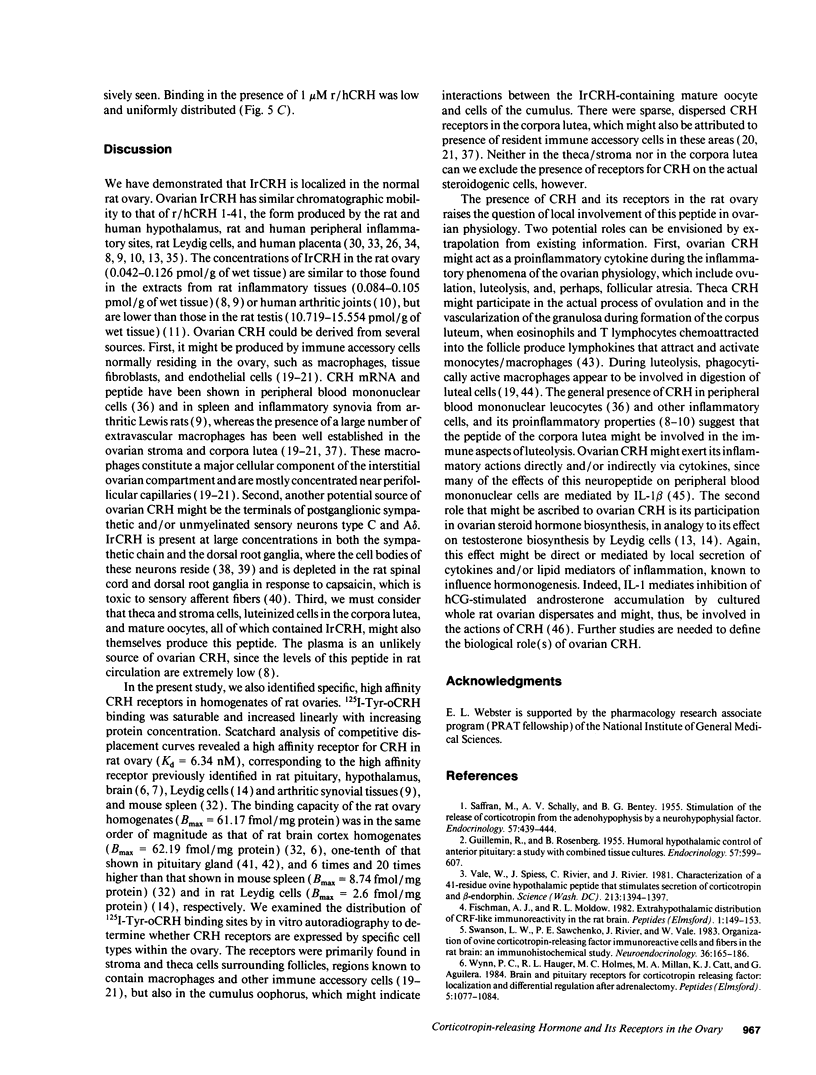

Images in this article
Selected References
These references are in PubMed. This may not be the complete list of references from this article.
- Adashi E. Y. Cytokine-mediated regulation of ovarian function: encounters of a third kind. Endocrinology. 1989 May;124(5):2043–2045. doi: 10.1210/endo-124-5-2043. [DOI] [PubMed] [Google Scholar]
- Adashi E. Y. The potential relevance of cytokines to ovarian physiology: the emerging role of resident ovarian cells of the white blood cell series. Endocr Rev. 1990 Aug;11(3):454–464. doi: 10.1210/edrv-11-3-454. [DOI] [PubMed] [Google Scholar]
- Audhya T., Hollander C. S., Schlesinger D. H., Hutchinson B. Structural characterization and localization of corticotropin-releasing factor in testis. Biochim Biophys Acta. 1989 Mar 16;995(1):10–16. doi: 10.1016/0167-4838(89)90226-4. [DOI] [PubMed] [Google Scholar]
- BULMER D. THE HISTOCHEMISTRY OF OVARIAN MACROPHAGES IN THE RAT. J Anat. 1964 Jul;98:313–319. [PMC free article] [PubMed] [Google Scholar]
- Brown M. R., Fisher L. A., Spiess J., Rivier C., Rivier J., Vale W. Corticotropin-releasing factor: actions on the sympathetic nervous system and metabolism. Endocrinology. 1982 Sep;111(3):928–931. doi: 10.1210/endo-111-3-928. [DOI] [PubMed] [Google Scholar]
- Calogero A. E., Bernardini R., Margioris A. N., Bagdy G., Gallucci W. T., Munson P. J., Tamarkin L., Tomai T. P., Brady L., Gold P. W. Effects of serotonergic agonists and antagonists on corticotropin-releasing hormone secretion by explanted rat hypothalami. Peptides. 1989 Jan-Feb;10(1):189–200. doi: 10.1016/0196-9781(89)90096-x. [DOI] [PubMed] [Google Scholar]
- Carey R. M., Varma S. K., Drake C. R., Jr, Thorner M. O., Kovacs K., Rivier J., Vale W. Ectopic secretion of corticotropin-releasing factor as a cause of Cushing's syndrome. A clinical, morphologic, and biochemical study. N Engl J Med. 1984 Jul 5;311(1):13–20. doi: 10.1056/NEJM198407053110103. [DOI] [PubMed] [Google Scholar]
- Chrousos G. P., Gold P. W. The concepts of stress and stress system disorders. Overview of physical and behavioral homeostasis. JAMA. 1992 Mar 4;267(9):1244–1252. [PubMed] [Google Scholar]
- Crofford L. J., Sano H., Karalis K., Webster E. L., Goldmuntz E. A., Chrousos G. P., Wilder R. L. Local secretion of corticotropin-releasing hormone in the joints of Lewis rats with inflammatory arthritis. J Clin Invest. 1992 Dec;90(6):2555–2564. doi: 10.1172/JCI116150. [DOI] [PMC free article] [PubMed] [Google Scholar]
- De Souza E. B. Corticotropin-releasing factor receptors in the rat central nervous system: characterization and regional distribution. J Neurosci. 1987 Jan;7(1):88–100. doi: 10.1523/JNEUROSCI.07-01-00088.1987. [DOI] [PMC free article] [PubMed] [Google Scholar]
- Erickson G. F., Magoffin D. A., Dyer C. A., Hofeditz C. The ovarian androgen producing cells: a review of structure/function relationships. Endocr Rev. 1985 Summer;6(3):371–399. doi: 10.1210/edrv-6-3-371. [DOI] [PubMed] [Google Scholar]
- Espey L. L. Ovulation as an inflammatory reaction--a hypothesis. Biol Reprod. 1980 Feb;22(1):73–106. doi: 10.1095/biolreprod22.1.73. [DOI] [PubMed] [Google Scholar]
- Fabbri A., Tinajero J. C., Dufau M. L. Corticotropin-releasing factor is produced by rat Leydig cells and has a major local antireproductive role in the testis. Endocrinology. 1990 Sep;127(3):1541–1543. doi: 10.1210/endo-127-3-1541. [DOI] [PubMed] [Google Scholar]
- Fischman A. J., Moldow R. L. Extrahypothalamic distribution of CRF-like immunoreactivity in the rat brain. Peptides. 1982 Mar-Apr;3(2):149–153. doi: 10.1016/0196-9781(82)90044-4. [DOI] [PubMed] [Google Scholar]
- GUILLEMIN R., ROSENBERG B. Humoral hypothalamic control of anterior pituitary: a study with combined tissue cultures. Endocrinology. 1955 Nov;57(5):599–607. doi: 10.1210/endo-57-5-599. [DOI] [PubMed] [Google Scholar]
- Grino M., Chrousos G. P., Margioris A. N. The corticotropin releasing hormone gene is expressed in human placenta. Biochem Biophys Res Commun. 1987 Nov 13;148(3):1208–1214. doi: 10.1016/s0006-291x(87)80261-9. [DOI] [PubMed] [Google Scholar]
- Hsu S. M., Raine L., Fanger H. A comparative study of the peroxidase-antiperoxidase method and an avidin-biotin complex method for studying polypeptide hormones with radioimmunoassay antibodies. Am J Clin Pathol. 1981 May;75(5):734–738. doi: 10.1093/ajcp/75.5.734. [DOI] [PubMed] [Google Scholar]
- Hsu S. M., Raine L., Fanger H. Use of avidin-biotin-peroxidase complex (ABC) in immunoperoxidase techniques: a comparison between ABC and unlabeled antibody (PAP) procedures. J Histochem Cytochem. 1981 Apr;29(4):577–580. doi: 10.1177/29.4.6166661. [DOI] [PubMed] [Google Scholar]
- Hume D. A., Halpin D., Charlton H., Gordon S. The mononuclear phagocyte system of the mouse defined by immunohistochemical localization of antigen F4/80: macrophages of endocrine organs. Proc Natl Acad Sci U S A. 1984 Jul;81(13):4174–4177. doi: 10.1073/pnas.81.13.4174. [DOI] [PMC free article] [PubMed] [Google Scholar]
- Hurwitz A., Payne D. W., Packman J. N., Andreani C. L., Resnick C. E., Hernandez E. R., Adashi E. Y. Cytokine-mediated regulation of ovarian function: interleukin-1 inhibits gonadotropin-induced androgen biosynthesis. Endocrinology. 1991 Sep;129(3):1250–1256. doi: 10.1210/endo-129-3-1250. [DOI] [PubMed] [Google Scholar]
- Karalis K., Sano H., Redwine J., Listwak S., Wilder R. L., Chrousos G. P. Autocrine or paracrine inflammatory actions of corticotropin-releasing hormone in vivo. Science. 1991 Oct 18;254(5030):421–423. doi: 10.1126/science.1925600. [DOI] [PubMed] [Google Scholar]
- Kavelaars A., Ballieux R. E., Heijnen C. J. The role of IL-1 in the corticotropin-releasing factor and arginine- vasopressin-induced secretion of immunoreactive beta-endorphin by human peripheral blood mononuclear cells. J Immunol. 1989 Apr 1;142(7):2338–2342. [PubMed] [Google Scholar]
- Kirsch T. M., Friedman A. C., Vogel R. L., Flickinger G. L. Macrophages in corpora lutea of mice: characterization and effects on steroid secretion. Biol Reprod. 1981 Oct;25(3):629–638. doi: 10.1095/biolreprod25.3.629. [DOI] [PubMed] [Google Scholar]
- LOBEL B. L., ROSENBAUM R. M., DEANE H. W. Enzymic correlates of physiological regression of follicles and corpora lutea in ovaries of normal rats. Endocrinology. 1961 Feb;68:232–247. doi: 10.1210/endo-68-2-232. [DOI] [PubMed] [Google Scholar]
- Merchenthaler I., Hynes M. A., Vigh S., Shally A. V., Petrusz P. Immunocytochemical localization of corticotropin releasing factor (CRF) in the rat spinal cord. Brain Res. 1983 Sep 26;275(2):373–377. doi: 10.1016/0006-8993(83)91001-6. [DOI] [PubMed] [Google Scholar]
- Munson P. J., Rodbard D. Ligand: a versatile computerized approach for characterization of ligand-binding systems. Anal Biochem. 1980 Sep 1;107(1):220–239. doi: 10.1016/0003-2697(80)90515-1. [DOI] [PubMed] [Google Scholar]
- Murdoch W. J., Steadman L. E., Belden E. L. Immunoregulation of luteolysis. Med Hypotheses. 1988 Nov;27(3):197–199. doi: 10.1016/0306-9877(88)90141-7. [DOI] [PubMed] [Google Scholar]
- Perrin M. H., Haas Y., Rivier J. E., Vale W. W. Corticotropin-releasing factor binding to the anterior pituitary receptor is modulated by divalent cations and guanyl nucleotides. Endocrinology. 1986 Mar;118(3):1171–1179. doi: 10.1210/endo-118-3-1171. [DOI] [PubMed] [Google Scholar]
- SAFFRAN M., SCHALLY A. V., BENFEY B. G. Stimulation of the release of corticotropin from the adenohypophysis by a neurohypophysial factor. Endocrinology. 1955 Oct;57(4):439–444. doi: 10.1210/endo-57-4-439. [DOI] [PubMed] [Google Scholar]
- Schürmeyer T. H., Avgerinos P. C., Gold P. W., Gallucci W. T., Tomai T. P., Cutler G. B., Jr, Loriaux D. L., Chrousos G. P. Human corticotropin-releasing factor in man: pharmacokinetic properties and dose-response of plasma adrenocorticotropin and cortisol secretion. J Clin Endocrinol Metab. 1984 Dec;59(6):1103–1108. doi: 10.1210/jcem-59-6-1103. [DOI] [PubMed] [Google Scholar]
- Shibahara S., Morimoto Y., Furutani Y., Notake M., Takahashi H., Shimizu S., Horikawa S., Numa S. Isolation and sequence analysis of the human corticotropin-releasing factor precursor gene. EMBO J. 1983;2(5):775–779. doi: 10.1002/j.1460-2075.1983.tb01499.x. [DOI] [PMC free article] [PubMed] [Google Scholar]
- Skofitsch G., Hamill G. S., Jacobowitz D. M. Capsaicin depletes corticotropin-releasing factor-like immunoreactive neurons in the rat spinal cord and medulla oblongata. Neuroendocrinology. 1984 Jun;38(6):514–517. doi: 10.1159/000123942. [DOI] [PubMed] [Google Scholar]
- Stephanou A., Jessop D. S., Knight R. A., Lightman S. L. Corticotrophin-releasing factor-like immunoreactivity and mRNA in human leukocytes. Brain Behav Immun. 1990 Mar;4(1):67–73. doi: 10.1016/0889-1591(90)90007-d. [DOI] [PubMed] [Google Scholar]
- Suda T., Tomori N., Tozawa F., Demura H., Shizume K., Mouri T., Miura Y., Sasano N. Immunoreactive corticotropin and corticotropin-releasing factor in human hypothalamus, adrenal, lung cancer, and pheochromocytoma. J Clin Endocrinol Metab. 1984 May;58(5):919–924. doi: 10.1210/jcem-58-5-919. [DOI] [PubMed] [Google Scholar]
- Swanson L. W., Sawchenko P. E., Rivier J., Vale W. W. Organization of ovine corticotropin-releasing factor immunoreactive cells and fibers in the rat brain: an immunohistochemical study. Neuroendocrinology. 1983;36(3):165–186. doi: 10.1159/000123454. [DOI] [PubMed] [Google Scholar]
- Udelsman R., Harwood J. P., Millan M. A., Chrousos G. P., Goldstein D. S., Zimlichman R., Catt K. J., Aguilera G. Functional corticotropin releasing factor receptors in the primate peripheral sympathetic nervous system. Nature. 1986 Jan 9;319(6049):147–150. doi: 10.1038/319147a0. [DOI] [PubMed] [Google Scholar]
- Ulisse S., Fabbri A., Dufau M. L. Corticotropin-releasing factor receptors and actions in rat Leydig cells. J Biol Chem. 1989 Feb 5;264(4):2156–2163. [PubMed] [Google Scholar]
- Vale W., Rivier C., Brown M. R., Spiess J., Koob G., Swanson L., Bilezikjian L., Bloom F., Rivier J. Chemical and biological characterization of corticotropin releasing factor. Recent Prog Horm Res. 1983;39:245–270. doi: 10.1016/b978-0-12-571139-5.50010-0. [DOI] [PubMed] [Google Scholar]
- Vale W., Spiess J., Rivier C., Rivier J. Characterization of a 41-residue ovine hypothalamic peptide that stimulates secretion of corticotropin and beta-endorphin. Science. 1981 Sep 18;213(4514):1394–1397. doi: 10.1126/science.6267699. [DOI] [PubMed] [Google Scholar]
- Webster E. L., De Souza E. B. Corticotropin-releasing factor receptors in mouse spleen: identification, autoradiographic localization, and regulation by divalent cations and guanine nucleotides. Endocrinology. 1988 Feb;122(2):609–617. doi: 10.1210/endo-122-2-609. [DOI] [PubMed] [Google Scholar]
- Wynn P. C., Harwood J. P., Catt K. J., Aguilera G. Regulation of corticotropin-releasing factor (CRF) receptors in the rat pituitary gland: effects of adrenalectomy on CRF receptors and corticotroph responses. Endocrinology. 1985 Apr;116(4):1653–1659. doi: 10.1210/endo-116-4-1653. [DOI] [PubMed] [Google Scholar]
- Wynn P. C., Hauger R. L., Holmes M. C., Millan M. A., Catt K. J., Aguilera G. Brain and pituitary receptors for corticotropin releasing factor: localization and differential regulation after adrenalectomy. Peptides. 1984 Nov-Dec;5(6):1077–1084. doi: 10.1016/0196-9781(84)90174-8. [DOI] [PubMed] [Google Scholar]
- Yoon D. J., Sklar C., David R. Presence of immunoreactive corticotropin-releasing factor in rat testis. Endocrinology. 1988 Feb;122(2):759–761. doi: 10.1210/endo-122-2-759. [DOI] [PubMed] [Google Scholar]



